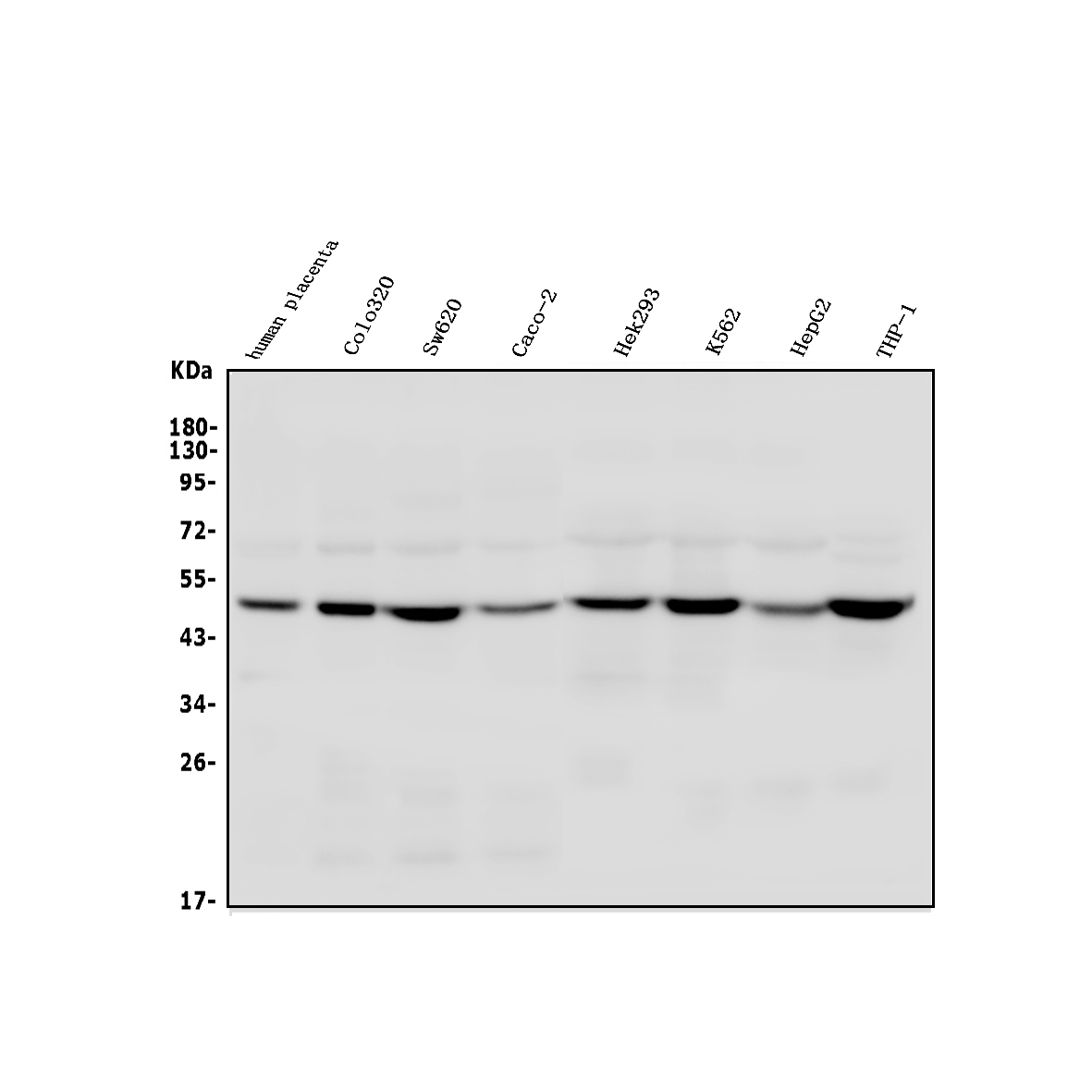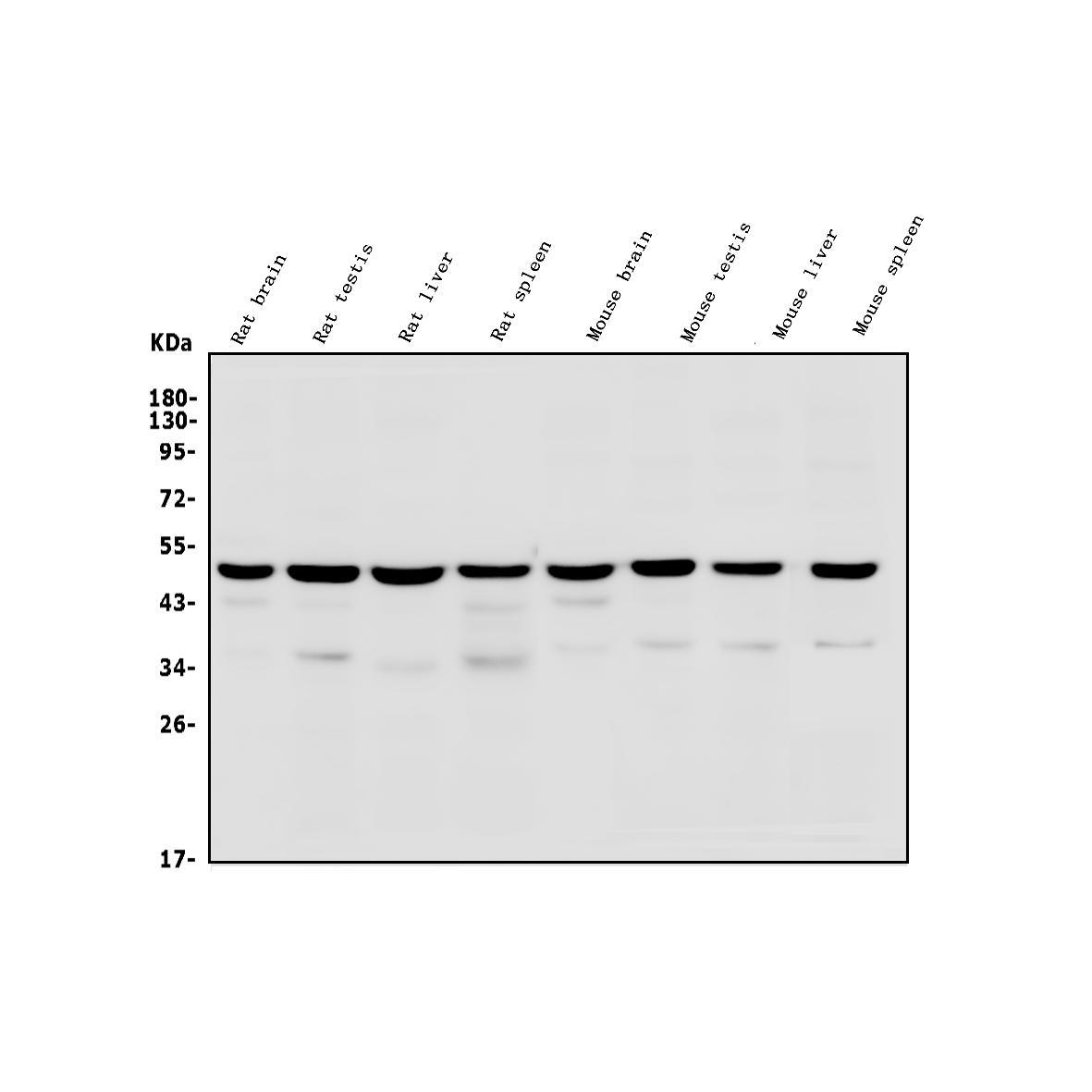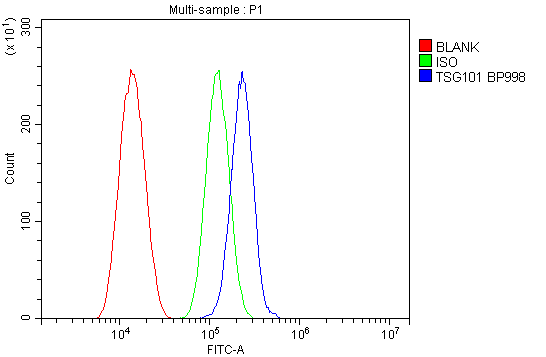| Western blot (WB): | 1:500-2000 |
| Flow Cytometry (Fixed): | 1:50-200 |
| Enzyme linked immunosorbent assay (ELISA): | 1:100-1000 |

Western blot analysis of TSG101 using anti-TSG101 antibody (A01233-2). The sample well of each lane was loaded with 30 ug of sample under reducing conditions.
Lane 1: human placenta tissue lysates,
Lane 2: human COLO320 whole cell lysates,
Lane 3: human SW620 whole cell lysates,
Lane 4: human CACO-2 whole cell lysates,
Lane 5: human HEK293 whole cell lysates,
Lane 6: human K562 whole cell lysates,
Lane 7: human HepG2 whole cell lysates,
Lane 8: human THP-1 whole cell lysates.
After electrophoresis, proteins were transferred to a membrane. Then the membrane was incubated with rabbit anti-TSG101 antigen affinity purified polyclonal antibody (A01233-2) at a dilution of 1:1000 and probed with a goat anti-rabbit IgG-HRP secondary antibody (Catalog # BA1054). The signal is developed using ECL Plus Western Blotting Substrate (Catalog # AR1197). A specific band was detected for TSG101 at approximately 44 kDa. The expected band size for TSG101 is at 44 kDa.

Western blot analysis of TSG101 using anti-TSG101 antibody (A01233-2). The sample well of each lane was loaded with 30 ug of sample under reducing conditions.
Lane 1: Rat brain tissue lysates,
Lane 2: Rat testis tissue lysates,
Lane 3: Rat liver tissue lysates,
Lane 4: Rat spleen tissue lysates,
Lane 5: Mouse brain tissue lysates,
Lane 6: Mouse testis tissue lysates,
Lane 7: Mouse liver tissue lysates,
Lane 8: Mouse spleen tissue lysates.
After electrophoresis, proteins were transferred to a membrane. Then the membrane was incubated with rabbit anti-TSG101 antigen affinity purified polyclonal antibody (A01233-2) at a dilution of 1:1000 and probed with a goat anti-rabbit IgG-HRP secondary antibody (Catalog # BA1054). The signal is developed using ECL Plus Western Blotting Substrate (Catalog # AR1197). A specific band was detected for TSG101 at approximately 44 kDa. The expected band size for TSG101 is at 44 kDa.

Flow Cytometry analysis of SiHa cells using anti-TSG101 antibody (A01233-2).
Overlay histogram showing SiHa cells stained with A01233-2 (Blue line). To facilitate intracellular staining, cells were fixed with 4% paraformaldehyde and permeabilized with permeabilization buffer. The cells were blocked with 10% normal goat serum. And then incubated with rabbit anti-TSG101 Antibody (A01233-2) at 1:100 dilution for 30 min at 20°C. DyLight®488 conjugated goat anti-rabbit IgG (BA1127) was used as secondary antibody at 1:100 dilution for 30 minutes at 20°C. Isotype control antibody (Green line) was rabbit IgG at 1:100 dilution used under the same conditions. Unlabelled sample without incubation with primary antibody and secondary antibody (Red line) was used as a blank control.

Western blot analysis of TSG101 using anti-TSG101 antibody (A01233-2). The sample well of each lane was loaded with 30 ug of sample under reducing conditions.
Lane 1: human placenta tissue lysates,
Lane 2: human COLO320 whole cell lysates,
Lane 3: human SW620 whole cell lysates,
Lane 4: human CACO-2 whole cell lysates,
Lane 5: human HEK293 whole cell lysates,
Lane 6: human K562 whole cell lysates,
Lane 7: human HepG2 whole cell lysates,
Lane 8: human THP-1 whole cell lysates.
After electrophoresis, proteins were transferred to a membrane. Then the membrane was incubated with rabbit anti-TSG101 antigen affinity purified polyclonal antibody (A01233-2) at a dilution of 1:1000 and probed with a goat anti-rabbit IgG-HRP secondary antibody (Catalog # BA1054). The signal is developed using ECL Plus Western Blotting Substrate (Catalog # AR1197). A specific band was detected for TSG101 at approximately 44 kDa. The expected band size for TSG101 is at 44 kDa.

Western blot analysis of TSG101 using anti-TSG101 antibody (A01233-2). The sample well of each lane was loaded with 30 ug of sample under reducing conditions.
Lane 1: Rat brain tissue lysates,
Lane 2: Rat testis tissue lysates,
Lane 3: Rat liver tissue lysates,
Lane 4: Rat spleen tissue lysates,
Lane 5: Mouse brain tissue lysates,
Lane 6: Mouse testis tissue lysates,
Lane 7: Mouse liver tissue lysates,
Lane 8: Mouse spleen tissue lysates.
After electrophoresis, proteins were transferred to a membrane. Then the membrane was incubated with rabbit anti-TSG101 antigen affinity purified polyclonal antibody (A01233-2) at a dilution of 1:1000 and probed with a goat anti-rabbit IgG-HRP secondary antibody (Catalog # BA1054). The signal is developed using ECL Plus Western Blotting Substrate (Catalog # AR1197). A specific band was detected for TSG101 at approximately 44 kDa. The expected band size for TSG101 is at 44 kDa.

Flow Cytometry analysis of SiHa cells using anti-TSG101 antibody (A01233-2).
Overlay histogram showing SiHa cells stained with A01233-2 (Blue line). To facilitate intracellular staining, cells were fixed with 4% paraformaldehyde and permeabilized with permeabilization buffer. The cells were blocked with 10% normal goat serum. And then incubated with rabbit anti-TSG101 Antibody (A01233-2) at 1:100 dilution for 30 min at 20°C. DyLight®488 conjugated goat anti-rabbit IgG (BA1127) was used as secondary antibody at 1:100 dilution for 30 minutes at 20°C. Isotype control antibody (Green line) was rabbit IgG at 1:100 dilution used under the same conditions. Unlabelled sample without incubation with primary antibody and secondary antibody (Red line) was used as a blank control.




